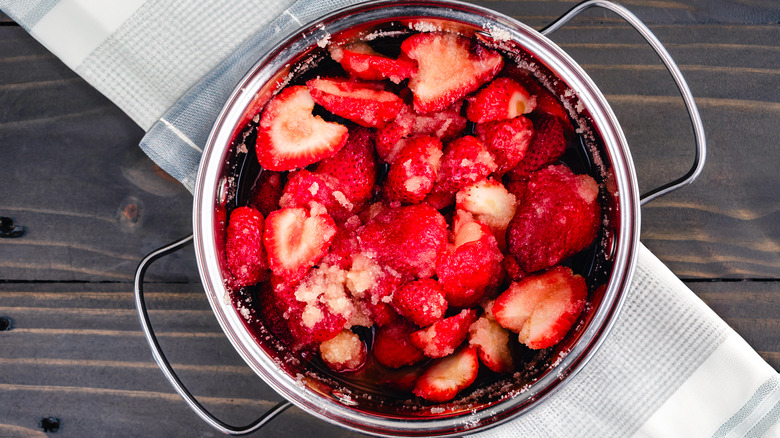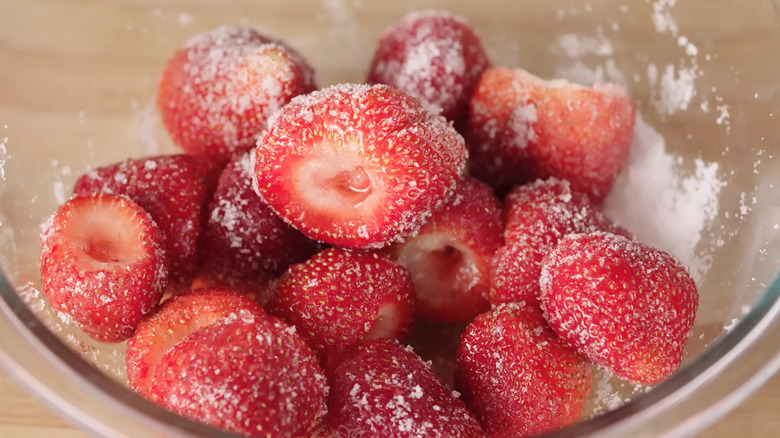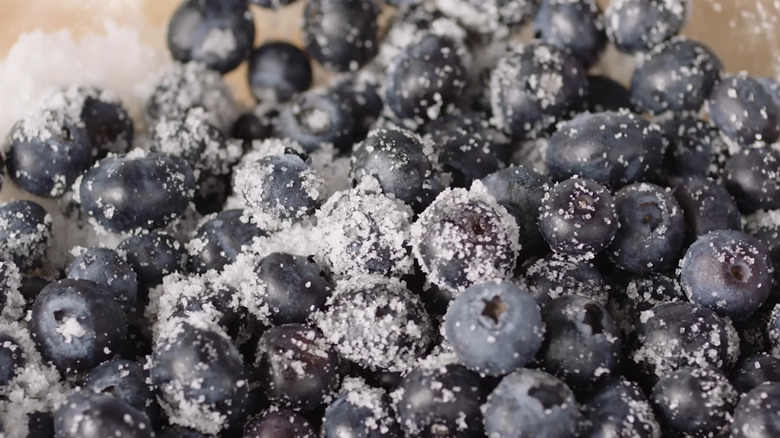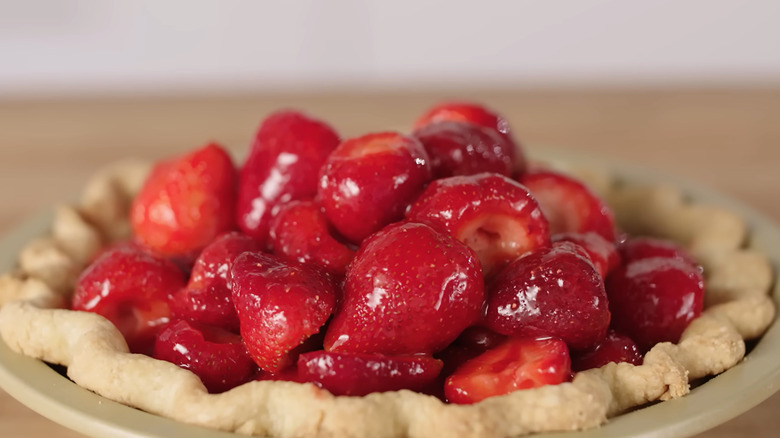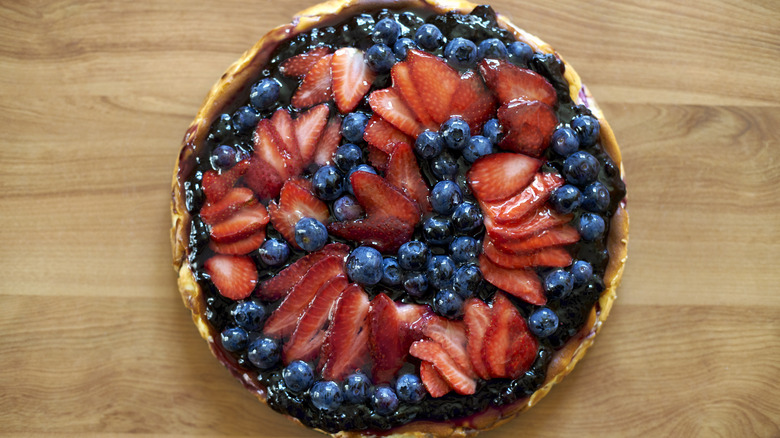The Science Behind Macerating Berries For A Sweeter Dessert
The term "maceration" is not the most appealing expression in the English language. The origins of the word macerate don't particularly help. While the original Latin word "macerare" meant "to soften" or "to steep," it later came to mean "to mortify" and, eventually, "waste away," particularly when associated with excessive fasting.
However, by the fifteenth century macerate took on a more culinary meaning, tying together both the "waste away" and "to steep" definitions. Macerated berries are left in a mixture that causes the berry to soften and wilt slightly while creating a delicious syrup. There are two processes that can be used to macerate berries, which might be thought of as wet and dry maceration, although both result in a sweet, juicy result. The easiest way to macerate berries is the dry method. All you have to do is take your berries and mix them with a little bit of granulated sugar and then wait. If that sounds shockingly simple, it's because it is. After setting your berries up, science takes over and does all the hard work.
How macerating berries in sugar works
The key to the macerating process is osmosis. To understand the process, we need to know some terms. A semi-permeable membrane is a barrier between two areas through which some things can pass, but others cannot. A solution is a mixture created by dissolving a solid, known as a solute, in a liquid, known as a solvent. When each side of a semi-permeable membrane has a solution of the same solute on each side of it, that is when osmosis can happen. The solvent will move through the semi-permeable membrane until the system reaches equilibrium, which is to say that the solution on both sides of the semi-permeable membrane has the same concentration of solute to solvent.
When it comes to macerating berries, the cell walls of the berries serve as our semi-permeable membrane. Berries are naturally full of sugar, with the juice inside of them being a solution of sugar and water. When you add the same solute, sugar, to the outside of the berries, it mixes with the water you rinsed the berries in or juice that is on the outside of the berries. Once this comes into contact with the cell walls of the berries, the juice leeches out of the berries to mix with the sugar.
Why does this osmosis effect make for such delicious berries? The liquid pulled out of the berries contains some of the flavor from the fruit, which then mixes with the sugar to make a natural syrup that pairs perfectly with the berries themselves. Additionally, the process also pulls some of the sugar through the semi-permeable membrane of the fruit, breaking down the cell walls slightly to make a tender berry, even if the berries were barely ripe and overly firm before.
How macerating berries in liquid works
The process for liquid maceration relies on many of the same scientific principles as the dry maceration method does. You're still using osmosis, but you are switching up the solvent. To wet macerate your berries, you simply add a splash of a liquid of your choice that contains either some sugar or acid to the fruit and let them sit.
If you use liquids that contain sugar, you still encourage osmosis. This includes liqueurs, wines, and of course sugar syrups such as maple syrup. The process can be a little slower for these as there is a lower sugar to solvent ratio on the outside, but the idea is the same. If you use an acid-based solvent, then the process is altered because it is not just based on osmosis. For example, the acid in balsamic vinegar breaks down the cell walls of the fruit, allowing the juice to escape and mix with the vinegar. Because of the acid present, macerating berries with vinegar or lemon juice takes less time than with wine or syrup.
Best practices for macerating berries
To get the purest results when macerating berries, your best bet is to simply dry macerate your berries in plain granulated sugar. If you want to add some zing and speed up the process, you can incorporate some lemon juice and zest. The juice, being an acid, will act as a catalyst to advance the maceration. You'll want to let the berries macerate for around 30 to 60 minutes but check and stir them regularly. You don't need much sugar; a cup of sugar would be enough for around 8 cups of berries.
If you're wet macerating your berries, you can use an even lower ratio of liquid to berries. The liquid will easily coat the outside and have a similar effect. Naturally, the liquid you use will alter the flavor of the berries, but there are plenty of great pairings that make for a great result.
There's no need to cut berries up, even if they have skins like blueberries or cherries. The osmosis will still work. Leave small berries whole and just cut larger ones, like strawberries, to the size that you would like in your dessert and macerate them like that (you won't want to try to cut them after you've macerated them). There's no need to add heat to any of this, as that will just get you on your way to making jam. Finally, bear in mind that this process will work best with firmer, riper berries which can break down nicely. Avoid softer or overripe berries for macerating as the result can easily go a bit too far and result in mushy berries.
What to do with macerated berries
You have your macerated berries sitting in a bowl surrounded by a delicious syrup. So, what do you do with your marinated berries? The options really are endless and it's hard to go wrong. The simplest option is just to grab a spoon and enjoy. This is particularly wonderful if you've used some flavoring in your maceration process. Sugar macerated berries with lemon or other citrus are a treat, and for a slightly boozy version you can macerate them in an orange liqueur or a triple-sec such as Cointreau or Drambuie.
Macerated berries are also delicious served with ice cream, on top of yogurt, on crepes, or inside a simple tart crust. Once macerated, your berries are best served or refrigerated immediately, as the fruit will get softer as the osmosis of the sugar solution approaches equilibrium. However, they can last as long as 4 to 5 days in the fridge and still be pretty good. For a quick and delicious way to use up leftover berries, try pairing it with a batch of biscuits and a scoop of ice cream.
